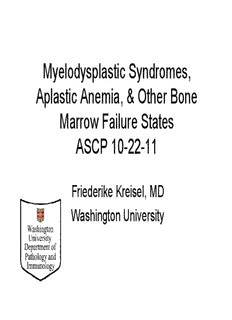
Myelodysplastic Syndromes, Aplastic Anemia, & Other Bone Marrow PDF
Preview Myelodysplastic Syndromes, Aplastic Anemia, & Other Bone Marrow
Myelodysplastic Syndromes, Aplastic Anemia, & Other Bone Marrow Failure States ASCP 10-22-11 Friederike Kreisel, MD Washington University Faculty/Author/Speaker Disclosure The faculty/speakers for this live session do not have relevant relationships with commercial interests to disclose CCrreeddiitt ttyyppee:: HHEEMMEE,, SSUURRGG Myelodysplastic Syndromes (MDS) • Clonal proliferation combined with increased apoptosis –– CCyyttooppeenniiaa((ss)) – Dysplasia in one or more myeloid lines – Ineffective hematopoiesis – Increased risk of transformation to acute myeloid leukemia (~30% of cases) Myelodysplastic Syndromes (MDS) • Incidence has increased from 3.3 per 100,000 in 2001 to 3.8 per 100,000 in 2006 – ~10% of MDS patients are <50 years old –– EExxcceeeeddiinnggllyy rraarree iinn cchhiillddrreenn ((00..0011 ppeerr 110000,,000000)) • The increase has been attributed to – Enhanced awareness – Aging population – Availability of more effective therapies, making hematologists more likely to pursue the diagnosis Pathophysiology of MDS • Genetic alterations – del(5q) is best understood MDS-associated molecular abnormality: RPS14 (codes for a ribosomal subunit) has been shown to induce a MDS phenotype when experimentally inhibited and to correct the MDS pphheennoottyyppee wwhheenn rreessuupppplliieedd ttoo cceellllss wwiitthh ddeell((55qq)) • Epigenetic alterations – DNA hypermethylation – silences gene transcription by hypermethylation of CpG islands in promotor regions – silencing of tumor suppressor genes – may to some degree be reversed by cytidine analogues (i.e. decitabine) that irreversibly bind DNA methyltransferases – decreased methylation throughout the genome Case #1 • 69-year old female with pancytopenia: – WBC: 2.2 (4.5-11 K/cumm) –– HHeemmoogglloobbiinn:: 1100..66 ((1133..00--1177..00 gg//ddll)) – Platelets: 103 (140-400 K/cumm) Patient #1 Peripheral Blood Monocyte PPsseeuuddoo--PPeellggeerr HHuueett NNeeuuttrroopphhiillss Normal Pseudo-Pelger Huet Patient #1 Patient #1 Bone Marrow Normal Patient #1 Patient #1, H&E Patient #1, Leder Normal, H&E Normal, Leder Spicules Normal Spicules Patient #1
Description: